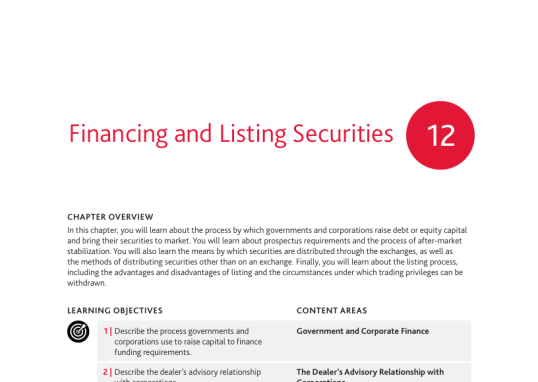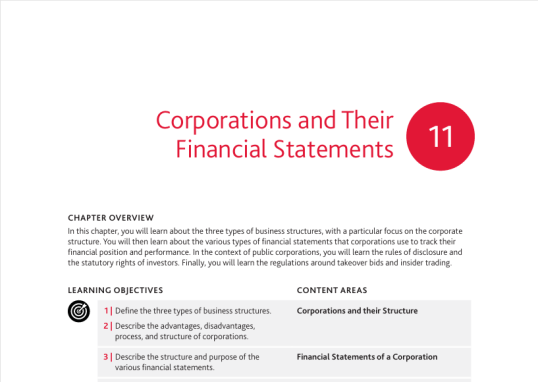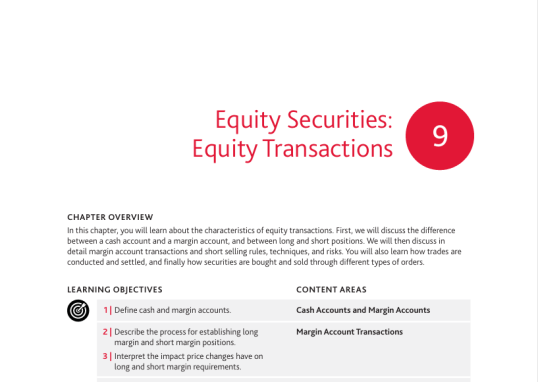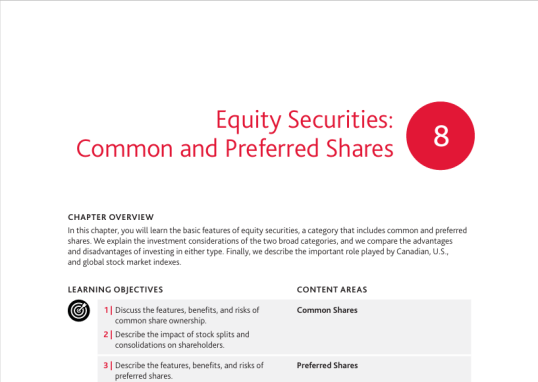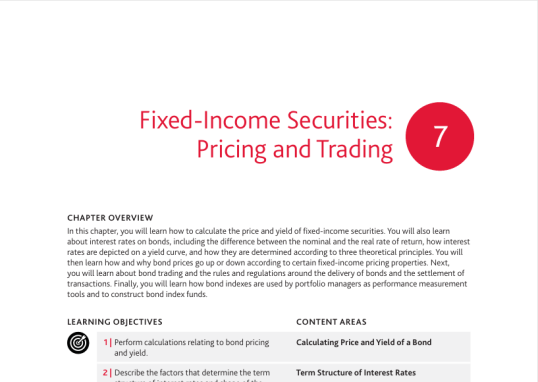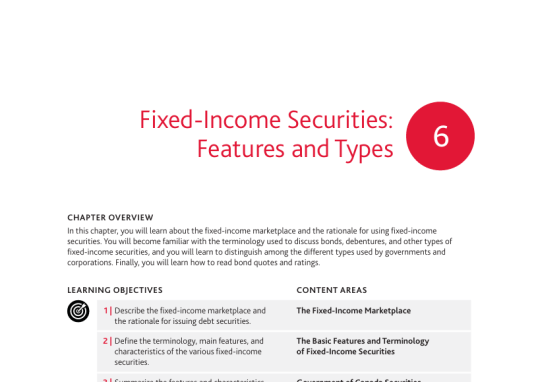CSC V.1 Chapter10 notes

In
DERIVATIVES
DERIVATIVES
- A derivative is a financial contract whose value is derived from the value of some other asset. The two basic types of derivatives are options and forwards
- Features common to all derivatives:
- All derivatives are contractual agreements between two parties, known as counterparties
- The price or formula for determining the price has been set in advance
- All derivatives have an expiration date
- Derivatives trade either over-the-counter (OTC) or through an organized exchange. The OTC market is a lightly regulated network of brokers and dealers. The exchange is a legal corporate entity. There is one derivatives exchange in Canada, the Bourse de Montreal. It lists options on stocks, indexes and U.S. currency, as well as exchange-traded forwards
- OTC Advantages: private transactions, no performance bond necessary, less regulated, customization
- Exchange Advantages: easy termination prior to expiry, clearinghouse guarantees financial performance
Table 10.1: Exchange-Traded and OTC Derivatives
| Traded on an exchange | Traded through computers and/or phone lines |
| Standardized contract | Terms of the contract agreed to between buyer and seller |
| Transparent (public) | Private |
| Easy termination prior to contract expiry | Early termination more difficult |
| Clearinghouse acts as third party guarantor | No third-party guarantor |
| Performance bond required | No performance bond required |
| Gains and losses accrue on a day-to-day basis (marking to market) | Gains and losses generally settled at the end of the contract, rather than marking to market |
| Heavily regulated | Much less regulated |
| Delivery rarely takes place | Delivery or cash settlement usually occurring |
| Commission visible | Fee usually built into price |
| Used by retail investors, corporations, institutional investors | Used by corporations and financial institutions |
TYPES OF UNDERLYING ASSETS
- Commodities – such as oil, gas, precious metals, wheat
- Financials – equity and equity indexes, interest rates, currencies
The most commonly used financial derivatives include equities, interest rates and currencies
USERS OF DERIVATIVES
- There are four main users of derivatives: Individual investors, institutional investors, businesses and corporations, and derivative dealers
- Investors – both individual and institutional – use derivatives for two purposes: Speculation and hedging
- Speculation – means taking on risk in order to enjoy higher returns
- Hedging – means reducing risk and sacrificing the potential for higher returns
- Institutional investors use derivatives for three main reasons:
- Market entry and exit – it is more efficient and cost-effective to carry out temporary changes to the portfolio using derivatives
- Arbitrage – refers to a scenario where the same asset or commodity is traded at different prices in different markets, allows the possibility of risk-free profits
- Yield enhancement – the most common method is selling options against a long position
OPTIONS
- An option contract gives the buyer (long position) the right to buy (call contract) or sell (put contract) at a specified price for a specified period of time. The seller of an option contract is obligated to buy (put contract) or sell (call contract) at a specified price for a specified period of time
- The specified price is known as the strike price or exercise price. To compensate the seller for taking on an obligation, the buyer of the option must pay a non-refundable amount of money, the premium
| Buyer or holder | Writer or seller | |
| Call | Pays premium and has the right to buy | Receives premium and has the obligation to sell |
| Put | Pays premium and has the right to sell | Receives premium and has the obligation to buy |
OPTIONS TERMINOLOGY
- Strike price – or exercise price is the price at which the underlying asset can be purchased or sold in the future
- Option premium – to obtain the right to buy or sell, buyers must pay the premium to the seller a fee, which is the option premium
- Expiration date – exchange-traded options expire at specific and established dates, which is the typically the third Friday of each month
- Trading unit – describes the size or amount of the underlying asset represented by one option contract. Exchange-traded stock options have a standard trading unit of 100 shares
- American-style and European-style – American-style options can be exercised at any time, up to and including the expiration date. European-style options can be exercised only on the expiration date
- Long-Term Equity Anticipation Securities – are long-term option contracts offering the same risks and rewards as a regular option
INTRINSIC VALUE AND TIME VALUE
- An opening transaction in an option trade occurs when a new position is established. An opening buy results in a long position while an opening sell results in a short position. Offsetting transactions are the opposite of opening transactions. By offsetting, the investor closes the position, eliminating either the right or obligation originally entered into
- Options are written with a variety of strike prices. The relation between the exercise price of the option and value of the underlying value of the asset establishes its intrinsic value
- XYZ Security is $25. It has $20 calls trading at $7, $25 calls trading at $2, and $30 calls trading at $1. We would say that the $20 call has $5 of intrinsic value, because it is would “intrinsically” be worth $5 to have that option and exercise it immediately. The $20 call would be in-the-money. The $25 call would have no intrinsic value and be at the-money. The $30 call would have no intrinsic value and be out-of the-money. The $7 value of the $25 call would be divided between $5 of intrinsic value and $2 of time value
- DEF Security is $50. It has $45 puts trading at $1.50, $50 puts trading at $2.50 and $55 puts trading at $6. The $55 put would have $5 of intrinsic value, because it would “intrinsically” be worth $5 to have that option and exercise it immediately. The $50 put would be at-the-money. The $45 put would be out-of-the money. The $6 value of the $55 put would be divided between $5 of intrinsic value and $1 of time value
OPTION PRICE = INTRINSIC VALUE + TIME VALUE
If an option has zero intrinsic value, then its entire value would be attributed to time value
OPTION STRATEGIES
- Buying call options:
- As a speculative strategy – buying calls allows investors to use leverage to increase the return relative to the investment made
- To manage risk – buying calls allows investors to lock in a price, assuming that they will receive the funds later
- Writing/selling call options:
- Covered call writing – investors own the underlying and sell options to receive the premium. The premium plus the exercise price becomes the total receipt
- Naked call writing – investors do not own the underlying, but sell the option to receive the premium
- Buying put options:
- As a speculative strategy – a less risky alternative to short-selling
- Buying puts to manage risk – as insurance against stocks investors hold, locking in a minimum sell price
- Writing put options:
- Cash secured put writing – investors have the cash to pay for the underlying security if assigned
- Naked put writing – investors sell the put in the hope of receiving the premium and not having the security put to them
FORWARDS AND FUTURES
- Forwards are contracts between two parties that bind both buyer and seller to buy/sell a specified asset at a specified price for a specified period of time
- When a forward is traded on an exchange, it is understood as a futures contract
- The buyer is the long and the seller is the short
- When futures are traded on an exchange, there is the requirement to deposit and maintain adequate margin in the futures account. There is daily settlement of gains and losses; this is known as marking-to-market
- Futures strategies are similar to option strategies in that they can be used to hedge positions and reduce risk or they can be used for speculative purposes
RIGHTS AND WARRANTS
- Rights and warrants are used by companies to raise investment capital instead of conducting a secondary offering
- A right is a privilege granted to a shareholder to acquire additional shares directly from the issuing company, at a discount to the current market price. This allows the company to raise investment capital, yet offer a benefit to existing shareholders at the same time
- EXAMPLE: “ABC Company declares a rights offering where each shareholder receives one right, and five rights plus $10 will allow the shareholder to purchase an additional treasury share.” (The market price of the shares is $12)
- When the rights offering is declared, the rights are “attached” to the shares, then the shares go “ex-rights”. The formula for the value of one right during the cum rights period:

- The formula for valuing one right during the ex-rights period:

- To determine the number of new shares that could be issued and total capital raised:

- A warrant is a security that gives its holder the right to buy shares in a company from its issuer at a set price for a set period of time. It is similar to a call option, except options are contracts between investors and the issuing company is not involved in option trading
- Warrants are often used as a sweetener as part of a package of a new debt or preferred share issue
- Warrants, like options, are comprised of intrinsic value and time value. If the exercise price of the warrant is lower than the current market price of the security, then the warrant has intrinsic value – the remainder of its value would be understood as being time value
- Companies raise additional funds through a rights offering because:
- Market conditions may not be conducive to a secondary offering of common shares
- The company may want to give existing shareholders the opportunity to maintain their proportionate ownership in the company
- Warrants are generally longer-lived than rights. Warrants are issued with terms of several years while rights are issued with terms of several weeks
Author
shanghaizhangyijie@gmail.com
